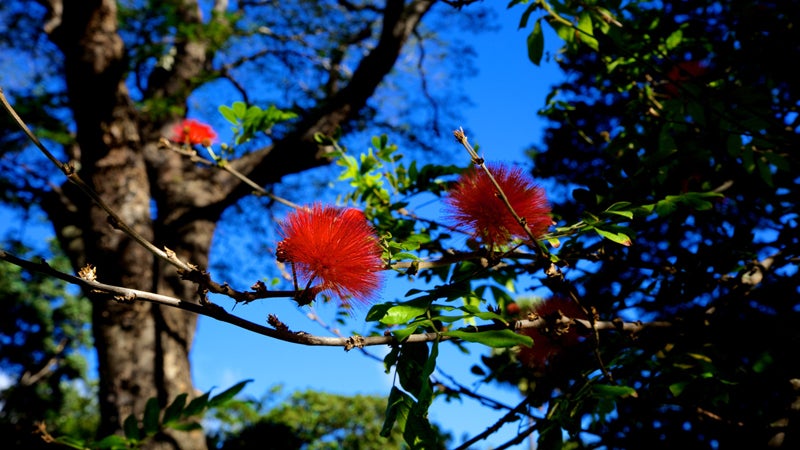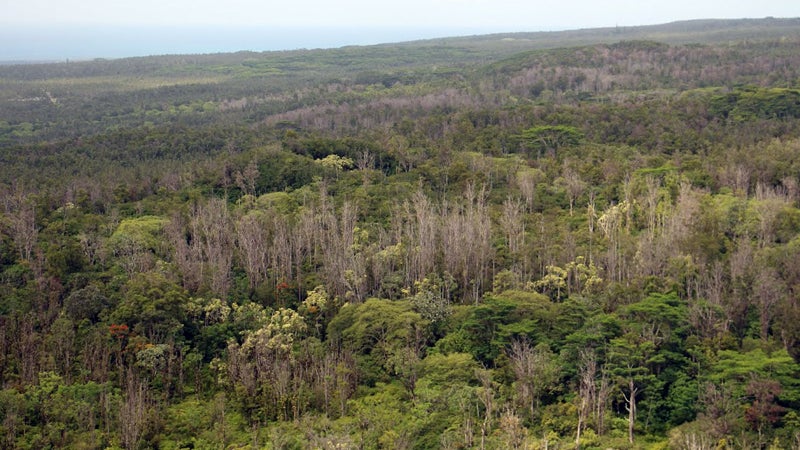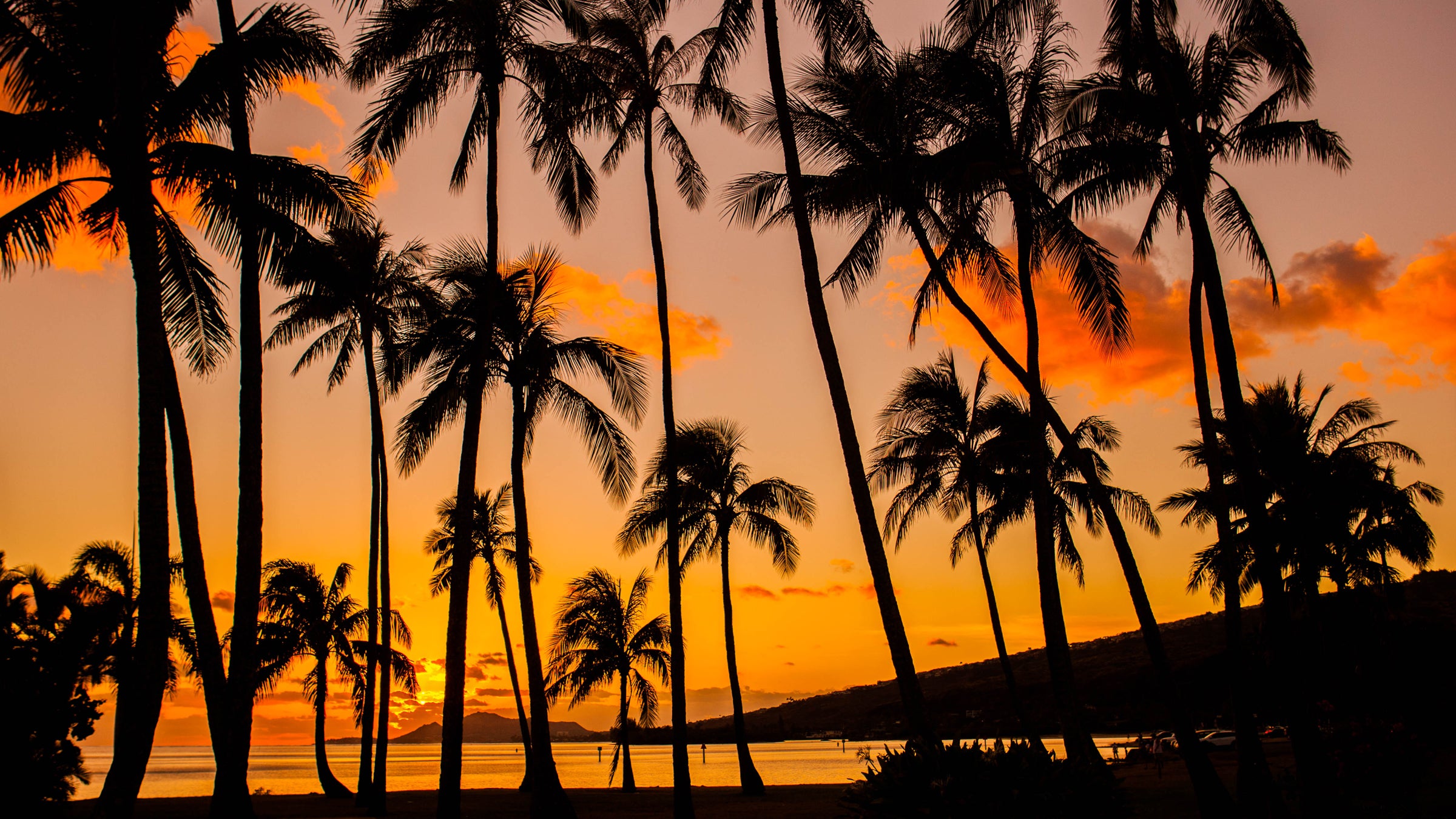Patient zero was probably in Puna, a lush, wild district not far from Volcanoes National Park on Hawaii’s Big Island. In 2010, the U.S. Forest Service and University of Hawaii started getting calls from distraught landowners in the area about ohia trees on their properties. Ohias, the bright, flowered trees that dominate nearly 50 percent of the island-state’s forests, are known for their ability to thrive nearly anywhere across the archipelago. But a swath of them had withered mysteriously and died in a matter of weeks.
It perplexed Flint Hughes, a Forest Service ecologist on the Big Island. Groves of aging ohia trees, which can live for 600 years, often die off together when they reach old age, but these were young trees that had turned brown and wilted. More calls started coming in from across Puna, all reporting the same problem: the ohias were dying, fast.
The Forest Service was stumped. It wasn’t until 2013, when Hughes and another ecologist checked on a particularly resplendent patch of forest owned and protected by the private Kamehameha Schools system, that the severity of the matter became apparent. The two men had been there a month earlier checking on seedling mortality. But rather than gazing at a grove of healthy trees, they stood over an ohia graveyard. The trees were alive a couple weeks ago, Hughes remembers thinking. “That was the alarm going off.”
“I’ve worked on invasive species for 20 years—and I’ve just never seen anything this virulent.”
Hawaii is a veritable bastion of sub tropic flora and fauna, and the Forest Service has addressed numerous ecological crises in the 57 years since the island cluster earned statehood. But whatever was killing the ohia threatened to leave much deeper wounds. The trees are a —they make up a huge majority of its canopy, and provide coverage for low-lying plants and food and habitat for honeycreeper birds—and are central to native Hawaiian culture.
In ancient Hawaii, ohia was a byword for strength, sanctity, and beauty, says Sam ‘Ohu Gon, senior scientist and cultural advisor for the . Ancient Hawaiians used the tree’s strong wood in canoes, spears, and homes; it was also the premier material used in temples, offering platforms, and oracle towers. When an ohia tree was removed from the forest for carving into an idol of the warrior god, Ku, tradition demanded a human sacrifice. “It’s a fundamental part of the intellectual foundation for Hawaii,” says Gon. “You can tell the whole history of Hawaii with ohia,” Hughes adds.

In 2012, diseased ohia covered about 2,300 acres in Puna. By 2014, dead ohia littered more than 15,000 acres of pristine rainforest. The disease was marching across the island of Hawaii, uncontained. Terrified the scourge would spread to other islands, the state government formed task forces and funded studies.
And yet, the disease remained a mystery. The very basics—the mechanism that causes the affliction—were unknown. Was it caused by volcanic activity? Seismic damage to roots? No one knew. It was maddening, Hughes said. “The trees that get hit by this become the breeding ground—they become the vectors. They sustain the disease so it can kill other trees around it. It’s really diabolical. It’s a lot like other pathogens that impact humans,” Hughes says. “I refer to it as ‘tree Ebola’ in talks if I really want to get people’s attention.”
For 70 million years, Hawaii existed in relative isolation. The plants and species that slowly arrived on this collection of volcanic rocks in the middle of the Pacific hitched rides on traveling birds or floated in on the waves. Over millennia, they evolved into completely unique species, unseen anywhere else on earth. The list of Darwinian creations on the islands includes the ohia tree.
It’s not surprising, then, that the arrival of man irrevocably altered this tropical Eden. We introduced deer that trampled through the undergrowth; pigs that ate ground-nesting birds; weeds that choked out native plants; fire ants that roam the beach. The ecological history of Hawaii, especially in today’s globalized world, is a story of continual invasion.
“We’re the invasive species capital of the world, I’m sure,” Hughes says, laughing. The cause of the disease, it seemed safe to assume, was another invader from beyond the breakers, imported by us. But still no one was sure just where it came from or how it got there.
By 2014, ecologists at the Forest Service and University of Hawaii tropical forest extension in Hilo knew they needed help, says J.B. Friday, an extension forester with the University of Hawaii College of Tropical Agriculture and Human Resources. Lisa Keith, a plant pathologist with the , got the call from a researcher at the university who had found fungi in samples of dead ohia. Could she take a look? “We needed to learn as much as we could as fast as we could,” she says. She began by taking the samples and performing “tree autopsies.” The inside of the ohia were discolored and showed signs of infection. The killer, it appeared, was clogging the tree’s vascular system, shutting off its water supply.
“There was a lot of stuff growing” inside the trees, Keith says, “but we’d constantly find Ceratocystis fimbriata.” A strain of C. fimbriata, a fungus and plant pathogen, was introduced to Hawaii decades ago, but records showed it had No one had ever seen the fungus do something like this to ohia.

Keith introduced pure cultures of the fungus into healthy ohia seedlings and waited. For months, nothing happened. Then one day a symptom appeared—browning leaves, discolored bark—and within one to two weeks the plant was dead. The fungus was likely a new strain of C. fimbriata, Keith and researchers realized, never before seen in the wild. It turned out the fungus could incubate inside trees for years (two to five for mature ohia), reproducing and slowly colonizing the ohia. “The tree can survive for a while—until it’s finally had enough,” Keith says.
The finding was dramatic: it’s exceedingly rare to discover a fungal strain attacking a new species (or “novel pathogenicity,” to the scientists involved), let alone to make the discovery in just a matter of months. As for the disease’s origin, no one could be sure, but experts assumed the fungus hadn’t originated in Hawaii. Keith and her cohort called the plague but Hawaiians came to know it by a different name: Rapid Ohia Death.
Finally the disease had a name and officials had some inkling of what they were dealing with. State agricultural and forest employees quickly alerted the public and, in the summer of 2015, they to prevent to the spread of Rapid Ohia Death, or ROD, from the Big Island .
“Ohia is widely considered the most important forest tree in Hawaii.”
“Ohia trees cover more than one million acres statewide and ohia is widely considered the most important forest tree in Hawaii,” Suzanne Case, the head of the state’s Department of Land and Natural Resources, . “They are so important for protecting our forest watersheds that it’s necessary our approach to combating this disease involves the highest levels of government and include non-government agencies.”
The fungi spreads like a virus, so transporting infected ohia wood to a new area could spell disaster. (In quarantine inspections of ohia wood leaving the island, Hughes says, about 60 percent is infected with ROD.) It is so tenacious, Keith and officials believe, the fungus can be transmitted through dirty tools, like chainsaws, and even woodland creatures or the wind, since the microscopic fungal spores need only a small wound to enter new trees.
If nothing else, Keith’s studies showed how aggressive the fungus was. The question became not How do we cure ROD? Keith says, but “How can you slow its spread? How can you manage something like this on a large scale?”
Greg Asner is up in the air every morning by 7 a.m. hunting for ROD. The skies are clearest early, he says. A Carnegie Institute for Science researcher and Stanford professor, is in high demand around the world. Last year, Asner used laser-guided imaging spectroscopy to in California’s drought-starved forests.
In Hawaii, where he’s lived for over 30 years, Asner through the sky. He retrofitted a hulking twin turboprop Dornier Do 228—a utility plane with enough room for 28 passengers—and packed its fuselage with high-tech imaging equipment to take the vital signs of foliage below. The silver and green “Carnegie Airborne Observatory” can identify trees under “physiological stress,” i.e. starved for water and potentially suffering early stages of ROD. Until Asner took up the case in January, all the surveys of ohia on the Big Island had been distinctly low-tech—ecologists either looked for browned trees in a helicopter or trudging through thick forests, looking for dying trees.
The view from 6,000 feet has not been good.
The extent of the disease is “worse than people think, even worse than Flint [Hughes] knows—and Flint knows better than anyone,” Asner says. “I’ve worked on invasive species for 20 years, and I’ve just never seen anything this virulent.”
But Asner, in his flying laboratory, isn’t just counting the dead. He is mapping out where trees are surviving the fungus. It’s part of a nascent, last-ditch plan from Keith, Hughes, Friday, and their respective departments to help the trees save themselves. It’s an idea, Asner says, that he can’t get out of his head: “We go out there, find the survivors, direct Flint’s field team to go collect seeds, then get Lisa [Keith] in there to find out physiologically why there might be resistance in there.”
“I refer to it as ‘tree Ebola.'”
“Just like when the Bubonic plague was going through Europe and people were dying by the millions, there were those that pulled through,” the Nature Conservancy’s Gon says. “They were the progenitors of the population after.” University of Hawaii conservationists are already for a seed bank, in preparation for the tree’s potential extinction.
The plan to find the survivors won’t take effect until summer, at the earliest. Until then, Hughes and the teams of scientists working on ROD have their work cut out for them. In January, officials confirmed the disease had spread to and near , home of the Ironman championships. If the disease continues unabated, it will redraw the landscape of Volcanoes National Park and beyond.
“Worst case scenario is that it spreads statewide and it decimates all of our ohia forests,” Robert Hauff, forest health coordinator at the state Department of Land and Natural Resources, told reporters in December. “It's a pretty bleak picture.”
There have been some successes, though. The fungus has so far been contained to the Big Island, which seems to experts like a minor miracle, and a public awareness campaign has residents chipping in to prevent the spread and protect one of the island’s most storied trees.
In the beautiful grove of ohia trees where Hughes first realized the severity of the disease four years ago, ROD has taken its toll. The Kamehameha Schools, which owns the forest, understood the importance of the ohia, Hughes says. Before the outbreak, the schools' land manager was working to protect the forest from another invader. “They were in the process of putting in a very expensive feral ungulate-proof fence around the entire parcel” to keep wild boar and other non-native hooved animals from wrecking the ecosystem, Hughes says. Today, the state-of-the-art fence stands around an area decimated by ROD, protecting nothing.
After the mechanism of ROD was finally unraveled, the Kamehameha land manager was devastated. “He just about broke down in tears,” Hughes says. Had his fencing spread the fungus? Was he to blame? The Forest Service veteran did his best to assuage the land manager’s guilt. The disease was completely absent four years ago, he said. No one could have known.
Last month, in hunting for the source of the fungus, Keith and her colleagues identified what they think may be its origin in Hawaii. The pathologists have found strains of the deadly fungus in a South American species of ornamental vine—the kind you'd install in your garden to give it that “tropical” feel—imported and sold in nurseries on the Big Island. It's just another plant humans have brought to the Aloha State, Hughes says. “We’ve been playing Russian Roulette with our ecosystem for decades, if not centuries,” he says.
“In terms of blame,” Hughes says, “we are to blame, unfortunately.”


